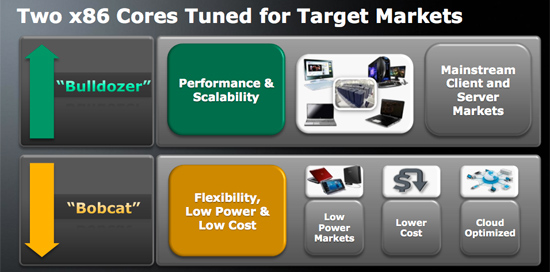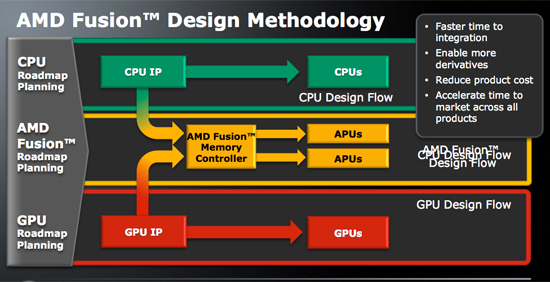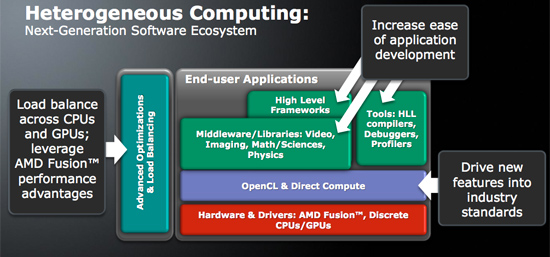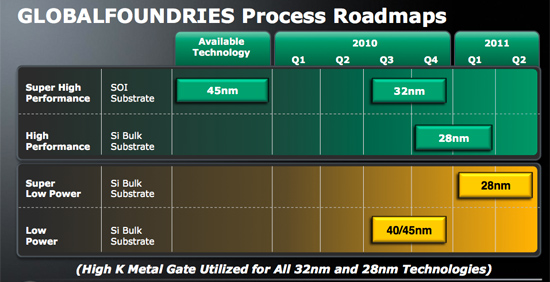AMD Unveils Bulldozer & Bobcat: 2011 Microachitectures
by Anand Lal Shimpi on November 11, 2009 5:00 PM EST- Posted in
- CPUs
I spoke too soon. Earlier today I outlined AMD’s roadmap for 2010 - 2011. In 2011 AMD will introduce two next-generation microarchitectures: Bulldozer for the high end desktop and server space and Bobcat for the price/power efficient ultra mobile market. I originally said that AMD wasn’t revealing any more about its next-gen architectures, but AMD just proved me wrong as they unveiled the first block diagrams of both cores.

First up, Bulldozer. I hinted at the architecture in this afternoon’s article:
“A major focus is going to be improving on one of AMD’s biggest weaknesses today: heavily threaded performance. Intel addresses it with Hyper Threading, AMD is throwing a bit more hardware at the problem. The dual integer clusters you may have heard of are the route AMD is taking...”
And here’s the block diagram:

Bulldozer: AMD's Latest Leap Forward, will it be another K8 to Intel's Sandy Bridge?
This is a single Bulldozer core, but notice that it has two independent integer clusters, each with its own L1 data cache. The single FP cluster shares the L1 cache of the two integer clusters.
Within each integer “core” are four pipelines, presumably half for ALUs and half for memory ops. That’s a narrower width than a single Phenom II core, but there are two integer clusters on a single Bulldozer core.
Bulldozer will also support AVX, hinted at by the two 128-bit FMAC units behind the FP scheduler. AMD is keeping the three level cache hierarchy of the current Phenom II architecture.
A single Bulldozer core will appear to the OS as two cores, just like a Hyper Threaded Core i7. The difference is that AMD is duplicating more hardware in enabling per-core multithreading. The integer resources are all doubled, including the schedulers and d-caches. It’s only the FP resources that are shared between the threads. The benefit is you get much better multithreaded integer performance, the downside is a larger core.
Doubling the integer resources but not the FP resources works even better when you look at AMD’s whole motivation behind Fusion. Much heavy FP work is expected to be moved to the GPU anyway, there’s little sense in duplicating FP hardware on the Bulldozer core when it will eventually have a fully capable GPU sitting on the same piece of silicon. While the first incarnation of Bulldozer, the Zambezi CPU, won't have an on-die GPU, presumably future APUs will use the new core. In those designs the Bulldozer cores and the GPU will most likely even share the L3 cache. It’s really a very elegant design and the basis for what AMD, Intel and NVIDIA have been talking about for years now. The CPU will do what it does best while the GPU does what it is good at.


Fascinating.
AMD’s Next-Generation Ultramobile Core: Bobcat
Next up is Bobcat:

AMD says that a single Bobcat is capable of scaling down to less than one watt of power. Typically a single microarchitecture is capable of efficiently scaling to an order of magnitude of TDP. If Bobcat can go low as 0.5W, the high end would be around 5W. If it’s closer to 1W at the low end then 10W would be the upper portion. Either way, it’s too low to compete in current mainstream notebooks, meaning that Bobcat is strictly a netbook/ultraportable core as AMD indicated in its slides. Eventually Bulldozer will probably scale down to take care of the mainstream mobile market.
AMD provided very little detail here other than it delivers 90% of today’s mainstream performance in less than half of the silicon area. If AMD views mainstream as an Athlon II X2, then Bobcat would deliver 90% of that performance in a die area of less than 60mm^2.
Clearly this is bigger than Atom, but that’s just a guess. Either way, the performance targets sound impressive. SSE1-3 are supported as well as hardware virtualization.

AMD wouldn’t tell me what process it would be made on but they did hint that Bobcat would be easily synthesizable. I take that to mean it will be built on a bulk 28nm process at Globalfoundries and not 32nm SOI.
Both of these cores will be out in 2011. We just need to make it through 2010 first.










68 Comments
View All Comments
GaiaHunter - Friday, November 13, 2009 - link
Sincerely I've been reading contradictory information everywhere.From what Anand said in here in response to my question, I would believe Zambezi would be release in 4 cores/8 threads and 8 cores/16 threads flavors.
But then JF-AMD, a server AMD guy in other forums, stated that "Interlagos" is 16 cores/16 threads, so at this moment I don't know what to think.
First, I was looking at Bulldozer has a CPU with HT, maybe requiring more hardware than Intel solution and maybe with more performance on the logical thread compared to Intel improvements, but now I'm starting to think that "Bulldozer module" is a dual-core with that actually uses less hardware to accomplish the same thing than current AMD CPUs (I'm not saying anything about how Phenom II compares to Bulldozer, especially because I don't know).
Really, I think the question I should have asked Anand was "Will Zambezi be released in 8 "Bulldozer Modules"/16 threads or only 4 "Bulldozer Modules"/8 Threads?"
I think maybe what I need to is review my way of thinking about cores in the AMD case.
Bulldozer seems to be a twin-core that can't be split, but otherwise is equivalent to the way we see 2 current cores.
qcmadness - Friday, November 13, 2009 - link
I don't think AMD will make next gen CPU without SMT support.AMD already stated that the lack of SMT support in K10 as a mistake. And I remember someone in AMD said that they try to put 32-thread in 1 socket at 32nm node. It could be if dual Zambezi MCM is achieved.
chiddy - Thursday, November 12, 2009 - link
Is it likely that bulldozer will be able to compete with sandy bridge/ivy bridge also due out around the same time?GaiaHunter - Thursday, November 12, 2009 - link
Thank you very much :)iwodo - Wednesday, November 11, 2009 - link
BullDozer Looks good... However, By the time they have BullDozer Core with an APU, Intel will already be launching IvyBridge.While BullDozer looks very well on paper to be better then Intel Nahalem in General Desktop Performance. SandyBridge is designed for improving IPC as well.
I can only wish AMD could accelerate their Roadmap.
Just a question pops up on my mind, When was the last time AMD push forward their Roadmap? Intel has a quite a few times pick up pace, while AMD always seems to lag behind themselves.
7Enigma - Thursday, November 12, 2009 - link
That's actually a very interesting question (when has AMD brought a CPU product to launch before originally expected).Anand could you comment?
mikeepu - Monday, November 16, 2009 - link
Wasn't Istanbul and shanghai slightly ahead of schedule?Glenn - Wednesday, November 11, 2009 - link
If they plan on 2011 we might see it in late 2012 and the world is coming to an end then, I heard?murray13 - Wednesday, November 11, 2009 - link
The overall look of fusion looks to me like way back in time when they added a 'co-processor' chip. Adding FP power.Only now they are taking away FP power and letting it be done by the chip that does it so well.
Old ideas never really go away.
K.I.S.S. rears its head again, I just hope performance will be up to the elegance of the architecture.
Eeqmcsq - Wednesday, November 11, 2009 - link
Why does the slide "Heterogeneous Computing" appear twice?